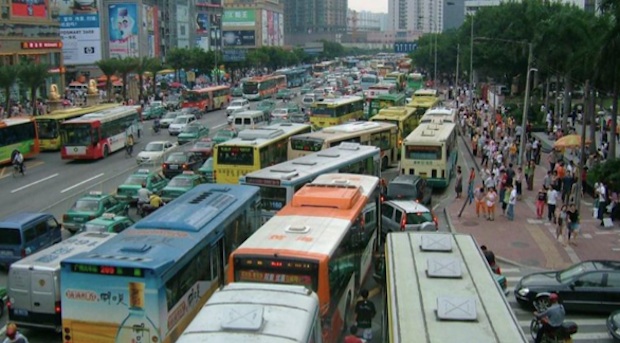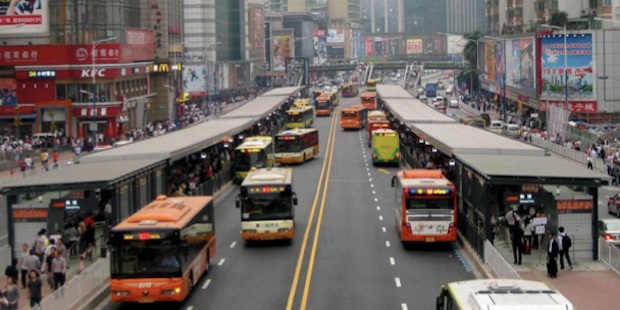M II A II R II K
Senior Member
Unclogging Chinese Traffic With A Bus System That Works
Aug 18, 2011
By Ariel Schwartz
Read More: http://www.fastcompany.com/1774557/...e-a-transportation-model-for-other-big-cities
PDF Report: http://www.itdp.org/documents/20110810-ITDP-GZBRTImpacts.pdf
China's transportation sector is troubled, to say the least. A problematic, pricey high-speed rail system and traffic jams that last for days are just a few of the issues that have arisen as China's population continues to grow. But amidst these problems is a transportation model to be hopeful about. Guangzhou, China--the third largest city in the country--opened a 14-mile bus rapid transit corridor last year in an attempt to lower congestion on one of the city's main roads. And so far, it's really working--so well, in fact, that the corridor could be used as an example for other Chinese cities, and perhaps even cities around the world.
The Institute for Transportation and Development Policy (ITDP) released this week a preliminary report examining the successes of Guangzhou's bus corridor along Zhongshan Avenue, which now has 805,000 daily boardings--giving it the title of most-used bus corridor in Asia--and an increase in the bus speed of 29% compared to the previous bus system in the area (before and after pictures are above). The system is so efficient that Guangzhou's bus system has slashed operating costs by over $14 million annually. So how did Guangzhou do it?
Most of the corridor's success is the result of crafty route planning. Before the system was implemented, over 40 bus routes served Zhongshan Ave. There were no segregated lanes for buses, causing traffic to increase because of frequent bus stopping points. An on-board payment system also significantly slowed down boarding times. The report explains how the new system has changed.
All stations have overtaking lanes allowing multiple sub-stops and express routes, and are designed and dimensioned according to the projected passenger demand and bus flows. Access to the center median stations is via a combination of pedestrian bridges, at-grade crossings, and pedestrian tunnels where combined with metros. Intersections along the corridor have restricted left turns. The system uses a "direct service" or "flexible" operational plan which allows buses to enter and leave the segregated lanes, instead of requiring transfers to/from feeder routes.
.....


[video=vimeo;21714344]http://www.vimeo.com/21714344[/video]
Aug 18, 2011
By Ariel Schwartz
Read More: http://www.fastcompany.com/1774557/...e-a-transportation-model-for-other-big-cities
PDF Report: http://www.itdp.org/documents/20110810-ITDP-GZBRTImpacts.pdf
China's transportation sector is troubled, to say the least. A problematic, pricey high-speed rail system and traffic jams that last for days are just a few of the issues that have arisen as China's population continues to grow. But amidst these problems is a transportation model to be hopeful about. Guangzhou, China--the third largest city in the country--opened a 14-mile bus rapid transit corridor last year in an attempt to lower congestion on one of the city's main roads. And so far, it's really working--so well, in fact, that the corridor could be used as an example for other Chinese cities, and perhaps even cities around the world.
The Institute for Transportation and Development Policy (ITDP) released this week a preliminary report examining the successes of Guangzhou's bus corridor along Zhongshan Avenue, which now has 805,000 daily boardings--giving it the title of most-used bus corridor in Asia--and an increase in the bus speed of 29% compared to the previous bus system in the area (before and after pictures are above). The system is so efficient that Guangzhou's bus system has slashed operating costs by over $14 million annually. So how did Guangzhou do it?
Most of the corridor's success is the result of crafty route planning. Before the system was implemented, over 40 bus routes served Zhongshan Ave. There were no segregated lanes for buses, causing traffic to increase because of frequent bus stopping points. An on-board payment system also significantly slowed down boarding times. The report explains how the new system has changed.
All stations have overtaking lanes allowing multiple sub-stops and express routes, and are designed and dimensioned according to the projected passenger demand and bus flows. Access to the center median stations is via a combination of pedestrian bridges, at-grade crossings, and pedestrian tunnels where combined with metros. Intersections along the corridor have restricted left turns. The system uses a "direct service" or "flexible" operational plan which allows buses to enter and leave the segregated lanes, instead of requiring transfers to/from feeder routes.
.....


[video=vimeo;21714344]http://www.vimeo.com/21714344[/video]




